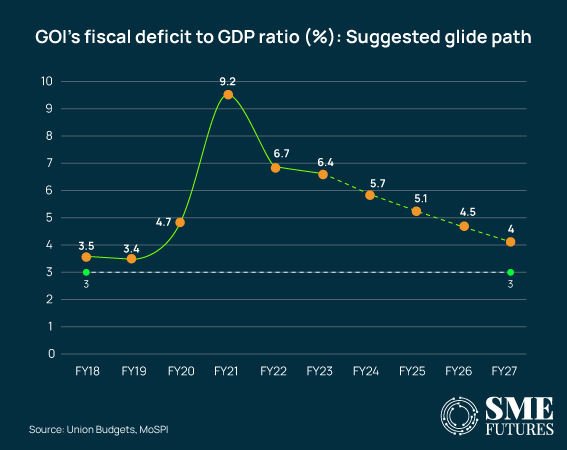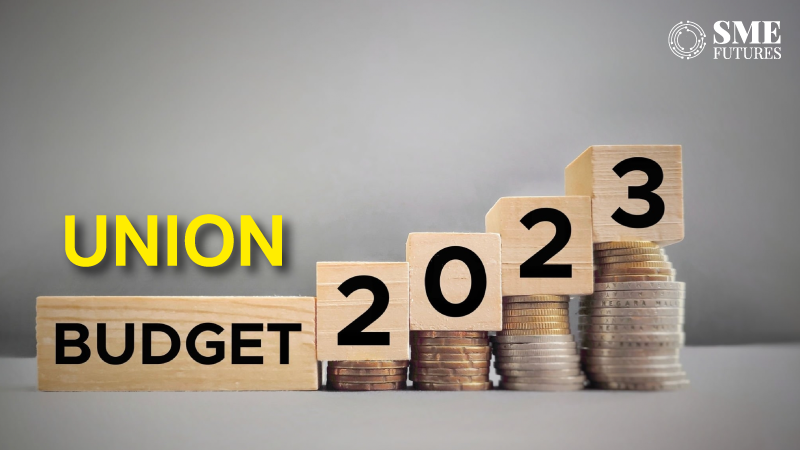Union Budget 2023-24 will be the first normal budget following the COVID-19 pandemic and the other global geopolitical developments. According to the available data, India’s nominal GDP growth is expected to slow down in 2023-24, putting pressure on the government to close the budget gap by cutting expenses.
Setting the narrative for the Union Budget, according to economists, the fiscal deficit for 2023-24 is expected at between 5.8 per cent and 6 per cent of the GDP, with the government pushing ahead with fiscal consolidation despite spending pressures. They added that the centre is expected to meet the budgeted fiscal deficit estimate of 6.4 per cent of the GDP for the current fiscal year.

According to Morgan Stanley’s pre-budget analysis, the gradual fiscal consolidation path will ensure that the focus on public capex spending is sustained, thus supporting the growth outlook. At the same time, Indian Inc. leaders have a lot of asks from the upcoming budget which are aimed at boosting the Indian economy.
Steady growth of economy
Mostly, the expectation from the Union Budget is to continue providing the right policies and the budgetary framework for ensuring economic growth. And a budget design that can stand as per the GDP growth rate expectations.
Also Read: Union Budget 2023: Recommendations for MSME Sector
Commenting on the pre-budget expectations, Rajeev Sharma, Chief Strategy Officer at Mitsubishi Electric India hopes that Budget 2023 will outline a clear path for India’s growth story, especially in the infrastructure and technology sectors.
“The manufacturing sector is expected to experience solid growth, which can be further strengthened by providing fiscal incentives and specific schemes in this budget. I strongly believe that the government will prioritise the policies that can benefit the infrastructure and manufacturing sectors and promote renewable energy, allowing the country to realise its potential on a global scale. Manufacturing investments must be encouraged among technology providers to bring self-reliant solutions to the country. Development of new-age manufacturing skills across the top and bottom of the pyramid must be facilitated which can be a game changer for further skill development,” he comments.
The overall expectation from the Union Budget is that it engenders steady growth for the present and future of the country.
Focus on decarbonisation agenda
India has set ambitious greenhouse gas emissions reduction targets for 2030 and 2070, which the experts say will take trillions of dollars to reach. The estimate majorly sees the overhauling of some key sectors which emit greenhouse gases with the help of technology.
The green hydrogen mission and the circular economy action plans will initiate a shift towards industrial decarbonisation. However, to achieve these targets, businesses are looking for more support systems, says Anup Garg, Founder, and Director at World of Circular Economy (WOCE).
“The Union Budget 2023-24 will have to change past trends in India’s budgetary spending and provide a rejuvenated push and an impetus to the ongoing environment and climate-change schemes to help decarbonise the country’s economy,” he says.
The corporates and starts-ups in this domain need government incentives and aggregation and de-risking for clean energy which should be complemented by setting standards for low-carbon materials. They also need skilling for battery recycling, and consultative processes for green infrastructure projects, he says.
“A ‘polluter pays’ policy, which has been talked about in the past too, should be there. It will help in bringing discipline as well as a stable cash flow to cover the expenses of green infrastructure and to stop the emissions and the carbon leakages in the system,” he continues.
Also Read: Businesses should adopt sustainable, green practices: Goyal
According to him, a budget allocation towards the development of carbon markets with strict compliances in place, is the need of the hour. “It will accelerate the transition to green India. This will also help to generate investment into low-carbon technologies beyond renewable energy,” he adds.
Watch: what-do-entrepreneurs-from-different-sectors-expect-from-union-budget-2023/
Zinc can aid economy
Zinc industry player Arun Misra, Chairman of IZA and CEO of Hindustan Zinc Limited is optimistic about the government’s initiatives in line with the Atmanirbhar Bharat vision which will propel the nation towards building a self-sustaining economy and enable it to embark on a new growth trajectory.
“I believe that the budget this year will focus on an approach that encourages more expenditure on a robust infrastructure. It is imperative for the government to put emphasis on the longevity of the nation’s assets and make a smart investment by using galvanised steel in these structures,” he points out.
Infrastructure like bridges, railways, and buildings are most vulnerable to rust and corrosion, which can be prevented through galvanisation, using a barrier coating of zinc. “The process not only contributes to the GDP of the country by reducing scrap but also minimises the recurring expenditure on replacements,” he says.
Further, in order to achieve the target of net zero by 2070, he suggests the reduction of duties. “Reduced duties on imported battery electric vehicles for mining applications will be a game-changer which will further encourage the industry players to swiftly move towards more sustainable solutions. I am hopeful that with this budget, the government will take a comprehensive approach, one that is rooted in foresight and concern for taking our nation’s ambition of a $5 trillion economy ahead and for reaching our net-zero target by 2070,” he adds.
Introduce PLI scheme
Several new sectors are hopeful about getting their own PLI scheme. Additionally, the government too is likely to announce enhanced allocations for PLI schemes.
Avneet Singh Marwah, Director and CEO, Super Plastronics Pvt. Ltd, a Kodak Brand Licensee, hopes that the TV manufacturing industry gets a PLI scheme this time.
“There is a dire need to include LED TVs in a PLI Scheme. The industry had undertaken huge efforts during the pandemic to support the economy. The entrepreneurs and the industry should feel secure while they plan to make more investments,” he says.
He also urges the government to reduce the GST slab for manufacturers. “We expect the government to come up with an updated tax regime and change the GST rate from 28 per cent to 18 per cent at least for TVs up to 40-inches. We suggest that the government should withdraw the decision to charge a customs duty of 5 per cent on open cell imports,” he elucidates.
Promote digital infra and skills
Industry leaders are expecting a lot from this year’s budget. One of the major demands is for an impetus towards building digital infrastructure and skills training.
“I think that this year’s budget should give digital infrastructure and skills a high priority. Although India may have a positive view of “digital” and technology, more needs to be done to support the country’s digital-first strategy as it aspires to become a US$ 5 trillion economy,” says Alok Dubey, Chief Finance Officer at Acer India.
The government’s commitment to digital skill development and its alignment with the IT Tech sector, and the PLI scheme targeted at helping manufacturers of IT hardware and computer servers need to receive equal weight in this year’s budget, he adds.
“Government policy could be changed to promote the development of talent and skills. The tech industry requires a talented and skilled workforce. The government should provide funding for programmes to modernise educational buildings with state-of-the-art R&D capabilities,” he asserts.
Give industry status to real estate
This one is the long pending demand of the real estate sector.
Ramesh Ranganathan, CEO, K Raheja Corp Homes says, “Firstly, the real estate sector needs to be given industry status. We expect policies and reforms that will further boost this industry, like tax breaks, single-window clearances, encouragement for home purchases and the rationalization of the GST on raw materials.”
With the government’s emphasis on housing, home purchases need to be incentivised through higher tax deductions, he further says.
“The residential property holding period needs to be revised downwards from 36 months to 12 months, for qualification as a long-term capital asset. To ensure a seamless balance of supply and demand, to promote ease of doing business and to drive further investments into the industry, a single-window clearance system is the need of the hour. Intervention is also needed to rationalize the GST rates for construction materials like steel and cement,” Ranganathan asserts.
Also Read: First Covid, now layoffs: Indian professionals undergo tremendous stress, anxiety
Demands from cable industry
With the increasing penetration of electricity in India, one segment that is witnessing good growth is the Indian wire and cable industry. According to the market research platform Absolute Reports, this market is poised to grow by $ 1.65 bn during 2021-2025, progressing at a CAGR of almost 4 per cent during the forecast period.
Shreegopal Kabra, Managing Director and Group President, RR Global hopes that this budget will help the industry to grow further. “I believe that the upcoming budget will help with the overall GDP and will create more demand and job opportunities in the wires and cables industry,” he says.
He also says that the government’s commitment to the WTO and its signing of many FTAs has allowed the country to continue to upscale its export business. “We believe that the government will consider correcting the inverted duty structure across sectors which is impacting domestic manufacturing, as muted external demand affects India’s exports and current balance,” he points out.
He also urges the government to prioritise giving substantial tax benefits to the manufacturing sector and to provide incentives for promoting the ‘Make in India’ initiatives. “As the government has already given tax relief to corporates, we expect that the manufacturing sector should be given at least a 50 per cent concession on income tax. The tax relief given to partnership companies, LLPs and individuals will lead to more disposal of liquidity, which will in turn increase the purchasing power and aid in the growth of the economy,” he adds.
Extension of ECLGS scheme
The government’s ECLGS scheme to support the COVID-19 hit MSME sector has seen 71 per cent (out of the total of the allocated 5 lakh crores) disbursals and is set to end in March 2023. Not having availed of the full credit available indicates the better health of the sector.
“However, considering the inflationary trends and the falling exports amid the global recessionary trends, we are hoping that the government will extend the validity period of the scheme,” says Manu Rishi Guptha, Founder & CEO of MRG Capital.
“The government hasn’t tweaked income tax slabs since the February 2020 budget, wherein tax rates were reduced albeit on the clause of not claiming any exemptions. In light of the current inflationary trends and in view of the FY24 elections, the government could offer some relief to the salaried class to increase the exemption limit from the current Rs 2.5 lakhs. With the current demand for housing and the government’s intention to do away with exemptions, we don’t expect any rise in the Rs 2 lakh deduction that one can currently claim on housing loan interests,” he elaborates.
Given that this is going to be the last budget before the general elections of 2024, the stakeholders are anticipating a populist budget. MSME and infrastructure-related announcements are also more likely. While direct and indirect tax collections will be buoyant, they will be offset by sticky food and farm subsidy bills, and lower disinvestment targets. So, we will have to wait and see how the FM lays out the plans to meet the fiscal deficit target and for the other relevant announcements in this year’s Union Budget.











